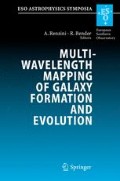Abstract
Determination of the star formation rate can be done using mid-IR photometry or Balmer line luminosity after a proper correction for extinction effects. Both methods show convergent results while those based on UV or on [OII]λ3727 luminosities underestimate the SFR by factors ranging from 5 to 40 for starbursts and for luminous IR galaxies, respectively. Most of the evolution of the cosmic star formation density is related to the evolution of luminous compact galaxies and to luminous IR galaxies. Because they were metal deficient and were forming stars at very high rates (40 to 100 M⊙ yr–1), it is probable that these (massive) galaxies were actively forming the bulk of their stellar/metal content at z ≤ 1.
Preview
Unable to display preview. Download preview PDF.
Author information
Authors and Affiliations
Editor information
Rights and permissions
About this paper
Cite this paper
Hammer, F., Flores, H., Liang, Y., Zheng, X., Elbaz, D., Cesarsky, C. Galaxy Formation and Evolution since z = 1. In: Renzini, A., Bender, R. (eds) Multiwavelength Mapping of Galaxy Formation and Evolution. ESO Astrophysics Symposia. Springer, Berlin, Heidelberg. https://doi.org/10.1007/10995020_40
Download citation
DOI: https://doi.org/10.1007/10995020_40
Published:
Publisher Name: Springer, Berlin, Heidelberg
Print ISBN: 978-3-540-25665-6
Online ISBN: 978-3-540-31641-1
eBook Packages: Physics and AstronomyPhysics and Astronomy (R0)

